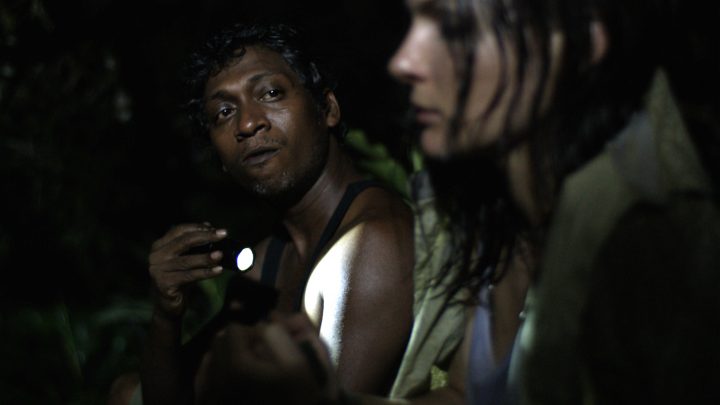And the ttff/16 Winners are…

The ttff awards prizes in three categories: jury prizes, people’s choice awards and special awards. The awards ceremony took place on Tuesday 27 September at the Central Bank Auditorium in Port of Spain.
JURY PRIZES
BEST FEATURE FILM–NARRATIVE
TT$12,500 / Sponsored by The National Gas Company
In competition:
Antes Que Cante El Gallo (Before the Rooster Crows)-Arí Manuel Cruz, Puerto Rico-WINNER
El Acompañante (The Companion) – Pavel Giroud, Cuba
Esteban-Jonal Cosculluela, Cuba
Play the Devil-Maria Govan, Trinidad+Tobago, The Bahamas, the USA
The Cutlass-Darisha Beresford, Trinidad+Tobago
BEST FEATURE FILM–DOCUMENTARY
TT$12,500 / Sponsored by The National Gas Company
In competition:
Se Bondye vie Yuli (God Willing Yuli)- Jean Jean,Haiti/Dominican Republic-WINNER
Make Mine Country-Ian Berry,St.Lucia
Diva:Enemy of the People-Tony Oldham, St.Lucia
BEST SHORT FILM–NARRATIVE
TT$7,500 / Sponsored by The National Gas Company
In competition:
Carapazón/Shell-Joa Vidal, Cuba- WINNER
SO.C13.TY-Khris Burton, Martinique
Nightmare Before Wedding-Orain-Chomaud Fabienne, Guadeloupe
Lost Boy-Aisha Porter-Christie, Jamaica
Rico-Lynda D’Alexis, Guadeloupe
BEST SHORT FILM–DOCUMENTARY
TT$7,500 / Sponsored by The National Gas Company
In competition:
Iceberg-Juliana Gómez, Cuba- WINNER
Blessed Love-Kra Kouassi, Guadeloupe
Welcoming Arms-Rosanne Ma, Bermuda
H20 -Clish Gittens, Barbados
BEST T+T FEATURE FILM
Trip to Regional Festival/Market
Sponsored by The Trinidad and Tobago Film Company (FilmTT)
In competition:
The Cutlass – Darisha Beresford + Play The Devil – Maria Govan – JOINT WINNERS
Tomb – Nicholas Attin
Sanskara – Christopher Din Chong
BEST T+T SHORT FILM – NARRATIVE
Trip to Regional Festival/Market
Sponsored by the Trinidad and Tobago Film Company
In competition:
Sweat-Josiah Persad- WINNER
Redman-Jared Prima
Dream Seller-Shane Lee Kit
BEST T+T SHORT FILM – DOCUMENTARY
Trip to Regional Festival/Market
Sponsored by the Trinidad and Tobago Film Company
In competition:
Who I say I Am- Amir Aether Valen Ali- WINNER
The Dying Swan: Ras Nijinsky in drag as Pavlova – Christopher Laird
How We Play with Fire – Desiree Sampson
Living Without You – Anna-Lisa Wickham
BEST FILM AS DECIDED BY A YOUTH JURY
TT$5,000 / Sponsored by COSTAATT
In competition:
Play The Devil-Maria Govan, Trinidad+Tobago, The Bahamas, the USA-WINNER
Battledream Chronicles-Alain Bidard, Martinique
Antes Que Cante El Gallo (Before the Rooster Crows) – Arí Manuel Cruz, Puerto Rico
Ixcanul-Jayro Bustamente, Guatemala
Mustang-Deniz Gamze-Ergüven, France
Mountains May Depart -Zia Zhange, China
Presos (Imprisoned) -Esteban Ramirez, Costa Rica
AMNESTY INTERNATIONAL HUMAN RIGHTS PRIZE
TT$5,000
In competition:
Se Bondye vie Yuli (God Willing Yuli) Jean Jean, Haiti/Dominican Republic-WINNER
Antes que Cante el Callo (Before the Rooster Crows) Arí Manuel Cruz, Puerto Rico
El Acompañante (The Companion) Pavel Giroud, Cuba
UNITED NATIONS T+T AWARD FOR BEST EMERGING DOCUMENTARY FILMMAKER
TT$5,000
In competition:
Amir Aether Valen Ali-Who I Say I Am-WINNER
Desiree Sampson-How We Play With Fire
Jamie Lee Loy-Super Me
Dylan Quesnel-Small Change
Kyle Sahadeo-The Absentee
PEOPLE’S CHOICE AWARDS
TT$5,000 each / Sponsored by Flow
BEST FEATURE FILM – NARRATIVE: THE CUTLASS – Darisha Beresford
BEST FEATURE FILM–DOCUMENTARY: LANDFILL HARMONIC – Brad Allgood + Graham Townsley
BEST SHORT FILM: SWEAT-Josiah Persad
RBC FOCUS: FILMMAKERS’ IMMERSION PITCH WINNER
TT$20,000 / Sponsored by RBC Royal Bank
Juliette McCawley, Avalon
CARIBBEAN FILM MART BEST PROJECT AWARD JOINT WINNERS
6 month consultation from international film industry professional Sydney Levine of SydneysBuzz
Karen Martinez, Scattered + Sonja Dumas, Angels Living in Tunapuna





![ttff-2016 - AT STARDUST CAFE - Stills [269698]](http://ttfilmfestival.com/wp-content/uploads/2016/08/ttff-2016-AT-STARDUST-CAFE-Stills-269698-480x720.jpg)
 His captive, Joanna, played by Lisa Hirschmann, narrates certain scenes that give insights into the mind of a person who has to succumb to a man she abhors yet depends upon for her survival. The director revealed at the Q&A session after the screening that Hirschmann walked through the forest barefooted and many of the scars that are seen about her body in the film are real. This level of commitment from an actor is partly what makes it possible for an under-resourced film to shine as ‘The Cutlass’ has.
His captive, Joanna, played by Lisa Hirschmann, narrates certain scenes that give insights into the mind of a person who has to succumb to a man she abhors yet depends upon for her survival. The director revealed at the Q&A session after the screening that Hirschmann walked through the forest barefooted and many of the scars that are seen about her body in the film are real. This level of commitment from an actor is partly what makes it possible for an under-resourced film to shine as ‘The Cutlass’ has. 